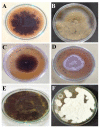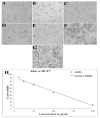GC-MS Based Characterization, Antibacterial, Antifungal and Anti-Oncogenic Activity of Ethyl Acetate Extract of Aspergillus niger Strain AK-6 Isolated from Rhizospheric Soil
- PMID: 37232710
- PMCID: PMC10217203
- DOI: 10.3390/cimb45050241
GC-MS Based Characterization, Antibacterial, Antifungal and Anti-Oncogenic Activity of Ethyl Acetate Extract of Aspergillus niger Strain AK-6 Isolated from Rhizospheric Soil
Abstract
Rhizospheric soil is the richest niche of different microbes that produce biologically active metabolites. The current study investigated the antimicrobial, antifungal and anticancer activities of ethyl acetate extract of the potent rhizospheric fungus Aspergillus niger AK6 (AK-6). A total of six fungal isolates were isolated, and isolate AK-6 was selected based on primary screening. Further, it exhibited moderate antimicrobial activity against pathogens such as Klebsiella pneumonia, Candida albicans, Escherichia coli, Shigella flexneri, Bacillus subtilis and Staphylococcus aureus. The morphological and molecular characterization (18S rRNA) confirmed that the isolate AK-6 belonged to Aspergillus niger. Further, AK-6 showed potent antifungal activity with 47.2%, 59.4% and 64.1% of inhibition against Sclerotium rolfsii, Cercospora canescens and Fusarium sambucinum phytopathogens. FT-IR analysis displayed different biological functional groups. Consequently, the GC-MS analysis displayed bioactive compounds, namely, n-didehydrohexacarboxyl-2,4,5-trimethylpiperazine (23.82%), dibutyl phthalate (14.65%), e-5-heptadecanol (8.98%), and 2,4-ditert-butylphenol (8.60%), among the total of 15 compounds isolated. Further, the anticancer activity of AK-6 was exhibited against the MCF-7 cell line of human breast adenocarcinoma with an IC50 value of 102.01 μg/mL. Furthermore, flow cytometry depicted 17.3%, 26.43%, and 3.16% of early and late apoptosis and necrosis in the AK-6 extarct treated MCF-7 cell line, respectively. The results of the present analysis suggest that the isolated Aspergillus niger strain AK-6 extract has the potential to be explored as a promising antimicrobial, antifungal and anticancer drug for medical and agricultural applications.
Keywords: Aspergillus niger; GC-MS analysis; antifungal; antimicrobial; apoptosis; rhizospheric soil.
Conflict of interest statement
The authors declare that there is no conflict of interest of this study.
Figures













References
-
- Cragg G.M., Newman D.J. Biodiversity: A continuing source of novel drug leads. Pure Appl. Chem. 2005;77:7–24. doi: 10.1351/pac200577010007. - DOI
-
- Rudrappa M., Kumar R.S., Nagaraja S.K., Hiremath H., Gunagambhire P.V., Almansour A.I., Perumal K., Nayaka S. Myco-Nanofabrication of silver nanoparticles by Penicillium brasilianum NP5 and their antimicrobial, photoprotective and anticancer effect on MDA-MB-231 Breast Cancer Cell Line. Antibiotics. 2023;12:567. doi: 10.3390/antibiotics12030567. - DOI - PMC - PubMed
-
- Yang T., Li X., Hu B., Wei D., Wang Z., Bao W. Soil microbial biomass and community composition along a latitudinal gradient in the arid valleys of southwest China. Geoderma. 2022;413:115750. doi: 10.1016/j.geoderma.2022.115750. - DOI
LinkOut - more resources
Full Text Sources
Miscellaneous

